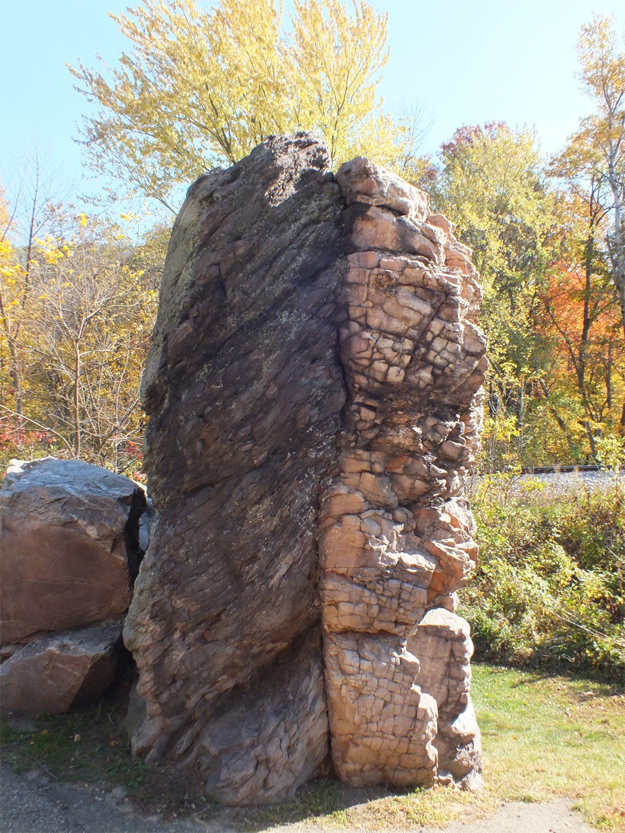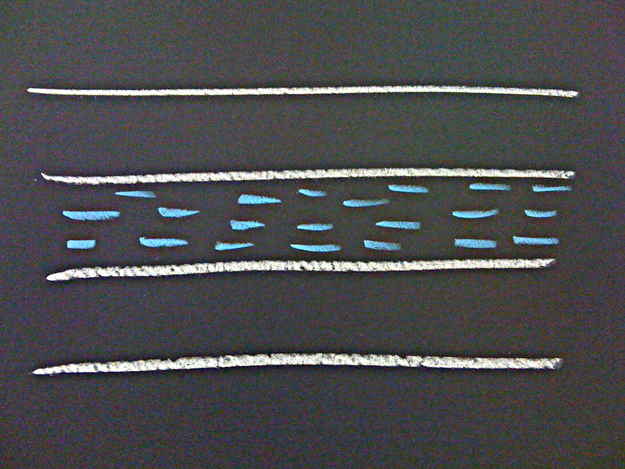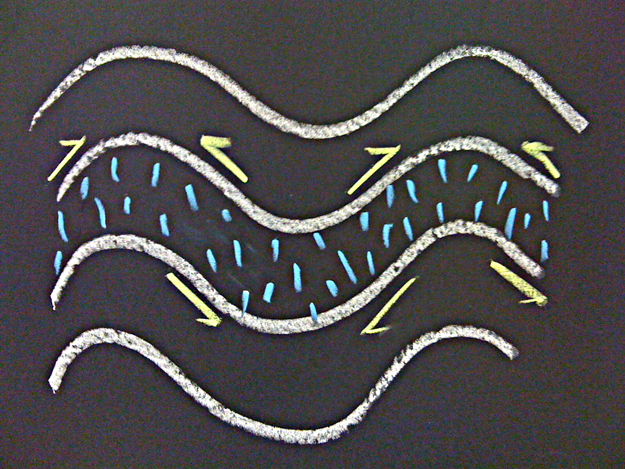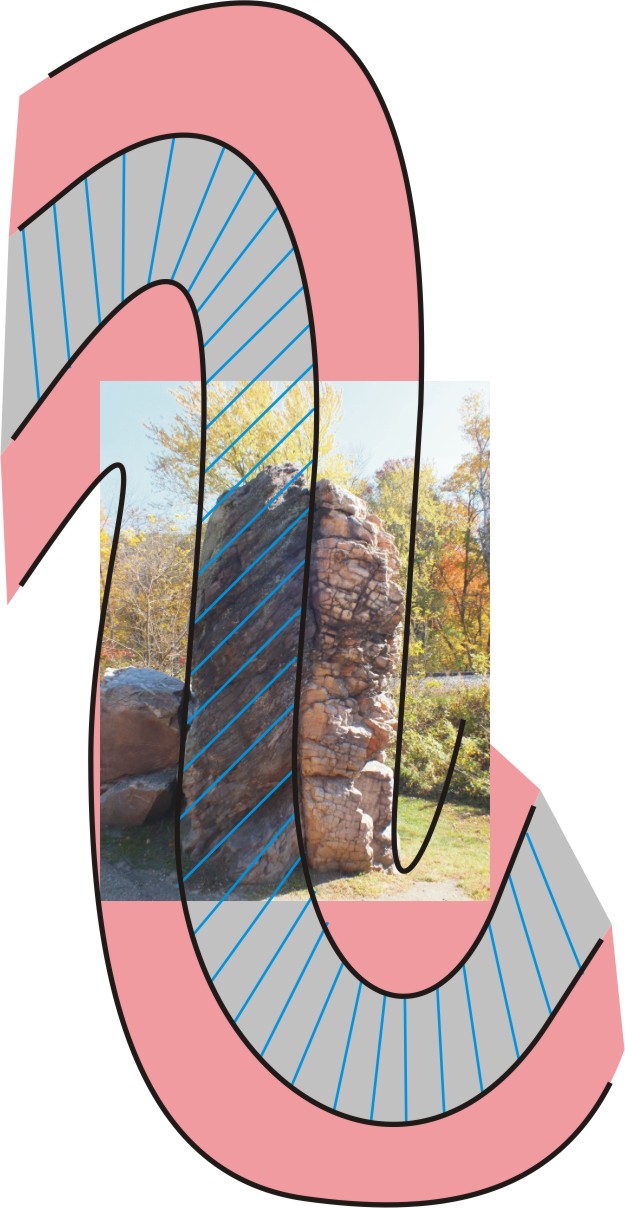21 October 2011
Friday fold: Van Hise Rock
Posted by Callan Bentley
Wednesday, Alton Dooley put up a post about his visit to Van Hise Rock in Wisconsin. He included this photo of the famous rock with its upright (pretty much vertical) layers:

Go read his description of the lithology for more detail, but essentially what you see here is an Oreo-like sandwich: pink quartzite (meta-sandstone) on each side of a central layer of gray phyllite (meta-mudstone). The phyllite displays a strong cleavage. The orientation of that cleavage (dipping towards the left side of the photo) tells us something.
This cleavage forms as layers of sedimentary rock are shortened horizontally during tectonic compression. Originally these rocks were deposited as (more or less) horizontal sheets of sand grains and itty bitty flakes of mud.

As they are squeezed from the side, they are metamorphosed, and their component clay minerals react to grow the mica minerals that are more stable at higher temperatures and pressures. It is these micas that imparted the characteristic shine to the foliation plane of phyllites. The micas are more stable growing perpendicular to the maximum stress direction, plus they may individually fold on very small scales to form new layers that are perpendicular to the maximum stress direction (crenulation cleavage). Pressure solution of soluble minerals and rotation of individual rigid grains may also contribute to the development of the new metamorphic fabric, the phyllite’s cleavage.

As deformation proceeds, the sandstone (now quartzite) buckles into a series of folds. Along the limbs of these folds, the sandstone shears the phyllite, and tilts its cleavage over in the direction of the fold hinge. The cleavage, formerly perpendicular to sedimentary layering, now intersects it at an angle, except at the fold hinge itself. The result is that the cleavage “fans” out across the fold.
The angular relationship between the cleavage and the bedding allows us to interpret the larger structure of which Van Hise Rock is an eroded remnant:

It is a vertical limb between an antiform on the left, and a synform on the right, as illustrated above. The hinge region of the antiform has been removed by erosion; the hinge area of the synform is buried beneath the surface. So if these beds are stratigraphically “right-side-up” (in other words, if the antiform is also an anticline), then the beds of Van Hise Rock are right on the verge of being tipped over. Imagine that we rotated these strata clockwise by 30°. Then they would be overturned, and the cleavage and bedding would be dipping in the same direction, though the bedding would be more steeply tilted than the cleavage.
Bottom line: though you might not know it to look at it, Van Hise Rock is part of a fold. Happy Friday.


 Callan Bentley is Associate Professor of Geology at Piedmont Virginia Community College in Charlottesville, Virginia. He is a Fellow of the Geological Society of America. For his work on this blog, the National Association of Geoscience Teachers recognized him with the James Shea Award. He has also won the Outstanding Faculty Award from the State Council on Higher Education in Virginia, and the Biggs Award for Excellence in Geoscience Teaching from the Geoscience Education Division of the Geological Society of America. In previous years, Callan served as a contributing editor at EARTH magazine, President of the Geological Society of Washington and President the Geo2YC division of NAGT.
Callan Bentley is Associate Professor of Geology at Piedmont Virginia Community College in Charlottesville, Virginia. He is a Fellow of the Geological Society of America. For his work on this blog, the National Association of Geoscience Teachers recognized him with the James Shea Award. He has also won the Outstanding Faculty Award from the State Council on Higher Education in Virginia, and the Biggs Award for Excellence in Geoscience Teaching from the Geoscience Education Division of the Geological Society of America. In previous years, Callan served as a contributing editor at EARTH magazine, President of the Geological Society of Washington and President the Geo2YC division of NAGT.
Glad my photo made Friday Fold!
The fold axis on this fold runs roughly east-west. Van Hise Rock is on the north limb of the fold, but the other limb also outcrops to the south, and cross bedding there confirms it’s a syncline.
We also measured some dips on Van Hise Rock and at a nearby quarry, and though you can’t easily tell looking at the photo, the rocks apparently are slightly overturned, by just a few degrees.
I’ll have some more stuff about this area posted in a few days.
[…] Callan Bentley’s post at Mountain Beltway for a similar diagram, and a more detailed description of why the cleavage tends to align this […]
[…] Mountain Beltway- This blog features an image of a fold every Friday, and last Friday it was a famous Wisconsin location- Van Hise Rock. As always, the author explains very clear just what the heck you’re looking at. Check it out before your next trip to Baraboo and impress the passengers in your car with your giant brain. […]